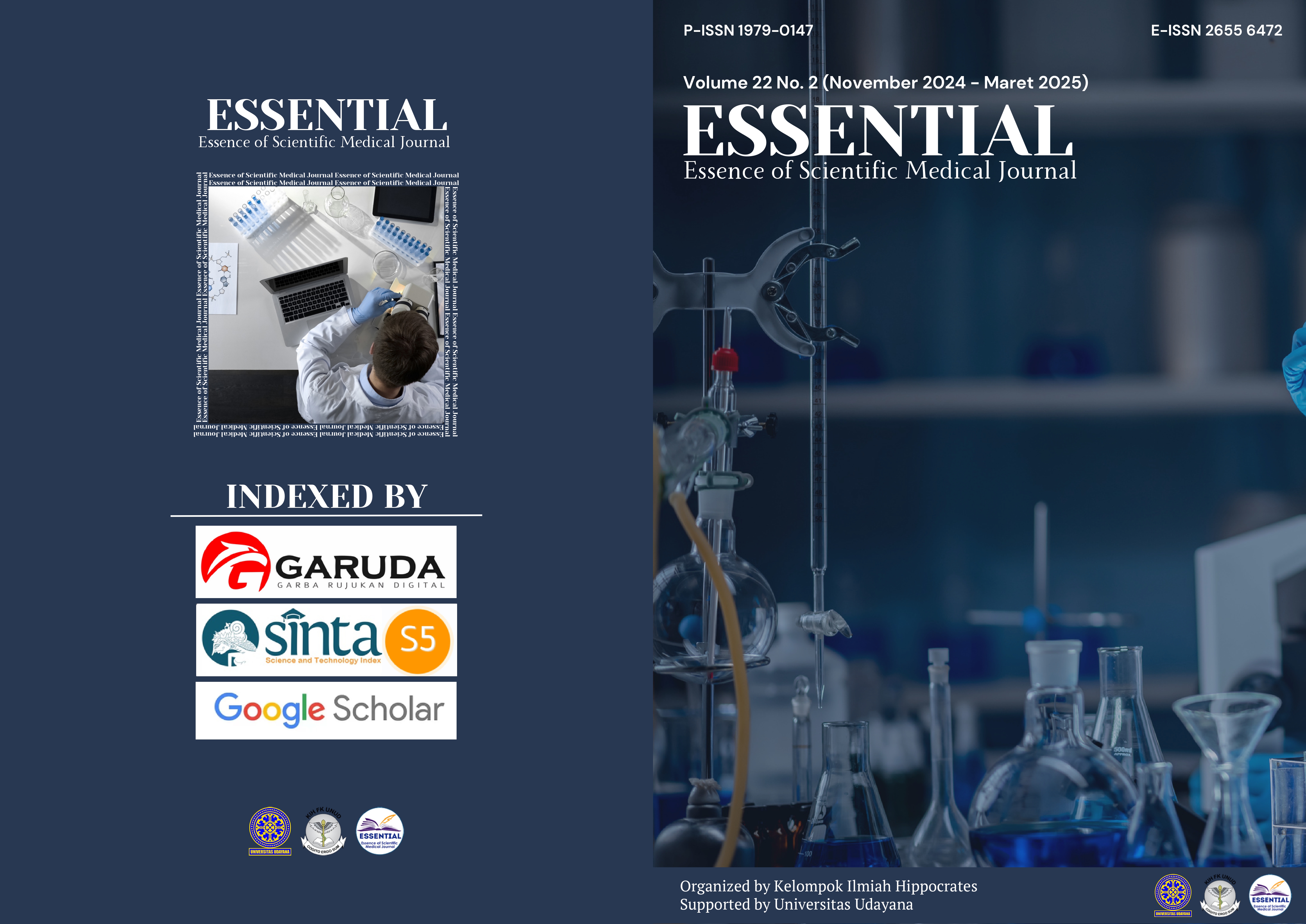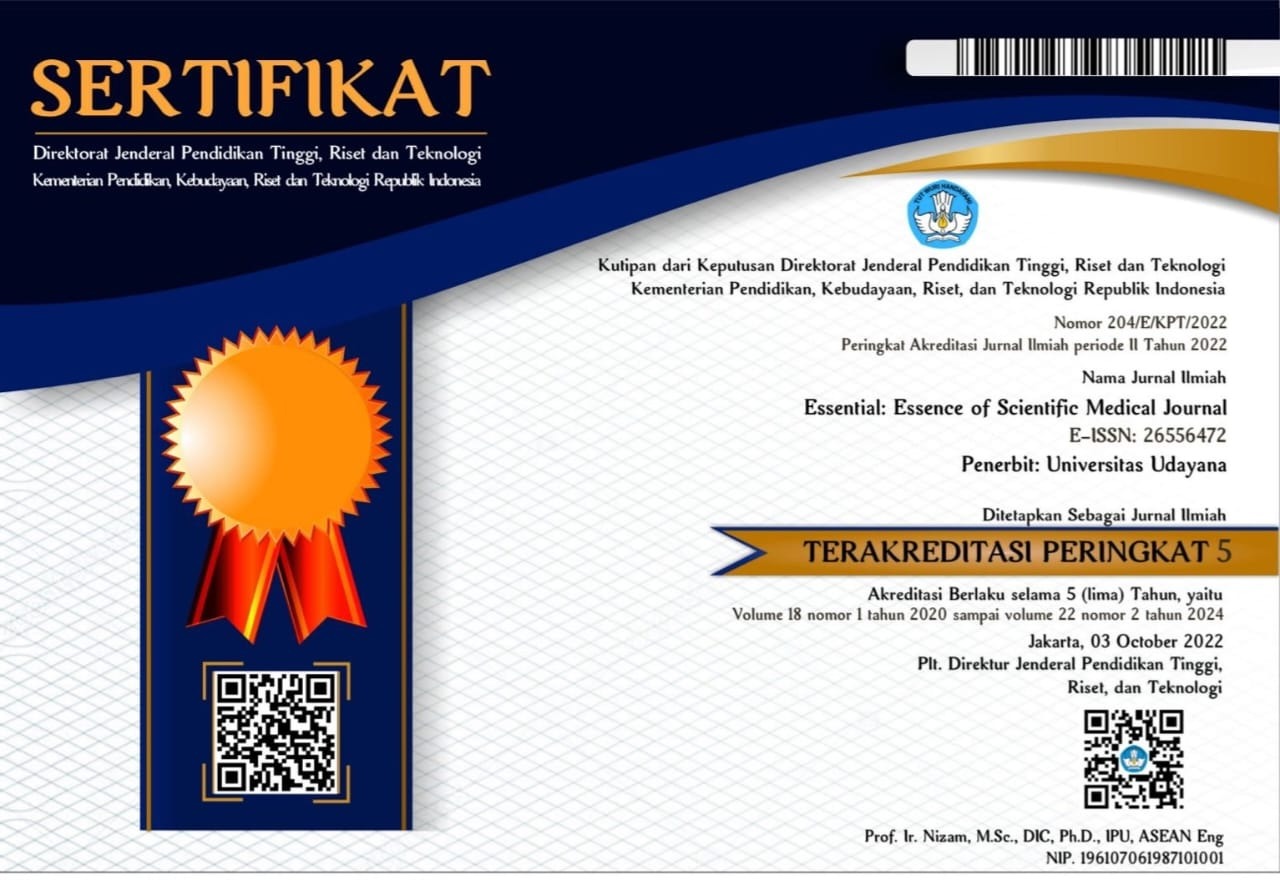HUBUNGAN ANTARA DURASI TIDUR DENGAN OBESITAS SENTRAL PADA REMAJA LAKI-LAKI
Abstract
Tidur termasuk elemen penting dalam hayat seorang insan karena turut berperan dalam regulasi asupan makan. Durasi tidur inadekuat yang penderitanya meningkat di kalangan remaja laki-laki dapat menimbulkan kondisi bertambahnya nafsu makan sehingga mengarah pada kejadian obesitas sentral. Tujuan dari penelitian ini adalah untuk mengetahui hubungan antara durasi tidur dengan obesitas sentral pada remaja laki-laki.
Penelitian ini termasuk penelitian analitik non-eksperimental dengan pengambilan data menggunakan metode cross-sectional. Responden dalam penelitian yaitu siswa sebuah SMA Negeri di Denpasar yang masih aktif mengikuti kegiatan sekolah. Data tingkat aktivitas fisik diperoleh dengan memakai kuisioner IPAQ-SF yang disebarkan secara daring kepada responden.
Data obesitas sentral diperoleh dengan pengukuran lingkar perut. Data penelitian dari 96 responden menunjukkan responden dengan durasi tidur kurang dari 8 jam (66,7%) lebih banyak dibanding dengan durasi tidur >=8j (33.3%). Sebanyak 39.6% responden tidak mengalami obesitas sentral.
Berdasarkan hasil analisis bivariat kedua variabel, diperoleh nilai p = 0,003 yang menyatakan hipotesis penelitian diterima. Berdasarkan hasil penelitian dapat disimpulkan bahwa terdapat hubungan antara durasi tidur dengan obesitas sentral pada remaja laki-laki. Tidur berpengaruh dalam kejadian obesitas sentral melalui produksi hormon yang meregulasi asupan makanan.
Kata kunci: durasi tidur, obesitas sentral, remaja laki-laki
Sleep is an important element in a person's life as it plays a role in the regulation of food intake. Inadequate sleep duration, which is increasing among adolescent boys, can lead to conditions that increase appetite, leading to the incidence of central obesity. The purpose of this study was to determine the relationship between sleep duration and central obesity in adolescent boys.
This study is categories in non-experimental analytical research with data collection using the cross-sectional method. Respondents in the study were students of a public high school in Denpasar who were still actively participating in school activities.
Data on physical activity levels were obtained using the IPAQ-SF questionnaire which was distributed online to respondents. Central obesity data was obtained by measuring abdominal circumference. Research data from 96 respondents showed that respondents with sleep duration less than 8 hours (66.7%) were more than those with sleep duration >=8 hours (33.3%). A total of 39.6% of respondents did not have central obesity.
Based on the results of bivariate analysis of the two variables, the p value = 0.003 was obtained, which stated that the research hypothesis was accepted. Based on the results of the study it can be concluded that there is a relationship between sleep duration and central obesity in adolescent boys. Sleep affects the incidence of central obesity through the production of hormones that regulate food intake.
Key words: adolescent boy, central obesity, sleep duration
Downloads
References
2. Kementrian Kesehatan Republik Indonesia. Riset Kesehatan Dasar Nasional. Riskesdas. 2018;76.
3. Riskesdas. Riset Kesehatan Dasar (RISKESDAS) 2013. Lap Nas 2013 [Internet]. 2013;1. Available from: http://www.dof.gov.my/en/c/document_library/get_file?uuid=e25cce1e-4767-4acd-afdf-67cb926cf3c5&groupId=558715
4. Claussen AH, Dimitrov L V., Bhupalam S, Wheaton AG, Danielson ML. Short Sleep Duration: Children’s Mental, Behavioral, and Developmental Disorders and Demographic, Neighborhood, and Family Context in a Nationally Representative Sample, 2016–2019. Prev Chronic Dis. 2023;20.
5. Kļaviņa-Makrecka S. Sleep Duration in Association with Subjective Health and Well-Being. Summary of the Doctoral Thesis. 2023 Jun 2 [cited 2024 Sep 24];2023. Available from: https://dspace.rsu.lv/jspui/handle/123456789/12289
6. Saxvig IW, Bjorvatn B, Hysing M, Sivertsen B, Gradisar M, Pallesen S. Sleep in older adolescents. Results from a large cross-sectional, population-based study. J Sleep Res. 2021;30(4):1–9.
7. Hermawan D, Muhani N, Sari N, Arisandi S, Yusmansyah M, Kristiana T, et al. Mengenal Obesitas [Internet]. Dewani H, editor. Penerbit Andi; 2020. Available from: https://books.google.co.id/books?id=mY%5C_5DwAAQBAJ
8. Muscogiuri G, Barrea L, Annunziata G, Di Somma C, Laudisio D, Colao A, et al. Obesity and sleep disturbance: the chicken or the egg? Crit Rev Food Sci Nutr [Internet]. 2019;59(13):2158–65. Available from: https://doi.org/10.1080/10408398.2018.1506979
9. Grigorakis DA, Georgoulis M, Psarra G, Tambalis KD, Panagiotakos DB, Sidossis LS. Prevalence and lifestyle determinants of central obesity in children. Eur J Nutr [Internet]. 2016 Aug 1 [cited 2024 Sep 25];55(5):1923–31. Available from: https://link.springer.com/article/10.1007/s00394-015-1008-9
10. Han SH, Yee JY, Pyo JS. Impact of Short Sleep Duration on the Incidence of Obesity and Overweight among Children and Adolescents. Med. 2022;58(8):1–9.
11. Kepmendikbudristekdikti. Pedoman penerapan kurikulum dalam rangka pemulihan pembelajaran. Menpendikbudristek [Internet]. 2022;1–112. Available from: https://jdih.kemdikbud.go.id/sjdih/siperpu/dokumen/salinan/salinan_20220711_121315_Fix Salinan JDIH_Kepmen Perubahan 56 Pemulihan Pembelajaran.pdf
12. Unicef. Secondary education [Internet]. 2022. Available from: https://data.unicef.org/topic/education/secondary-education/
13. Mubarak. Konsep istirahat dan tidur universitas muhammadiah malang. J Chem Inf Model. 2017;110(9):1689–99.
14. Husaini A. Dampak Gangguan Tidur Terhadap Performa Akademik Mahasiswa: Studi Literatur. 2021.
15. Ambarwati R. Tidur, irama sirkadian dan metabolisme tubuh. J Keperawatan [Internet]. 2017;X(1):42–6. Available from: http://www.litbang.kemkes.go.id:8080/handle/123456789/33428
16. Who.int. Physical Activity. World Health Organization (WHO). 2018.
17. Kelly DM, Jones TH. Testosterone and obesity. Obes Rev [Internet]. 2015 Jul 1 [cited 2024 Sep 25];16(7):581–606. Available from: https://onlinelibrary.wiley.com/doi/full/10.1111/obr.12282
18. Marttila J, Sipola P, Juutilainen A, Sillanmäki S, Hedman M, Kuusisto J. Central Obesity is Associated with Increased Left Ventricular Maximal Wall Thickness and Intrathoracic Adipose Tissue Measured with Cardiac Magnetic Resonance. High Blood Press Cardiovasc Prev [Internet]. 2024 Jul 1 [cited 2024 Sep 25];31(4):389–99. Available from: https://link.springer.com/article/10.1007/s40292-024-00659-9
19. Nan J, Chen M, Yuan H, Cai S, Piao W, Li F, et al. Prevalence and Influencing Factors of Central Obesity among Adults in China: China Nutrition and Health Surveillance (2015–2017). Nutr 2024, Vol 16, Page 2623 [Internet]. 2024 Aug 9 [cited 2024 Sep 25];16(16):2623. Available from: https://www.mdpi.com/2072-6643/16/16/2623/htm
20. Xue Y, Yang X, Liu G. Association of combined body mass index and central obesity with cardiovascular disease in middle-aged and older adults: a population-based prospective cohort study. BMC Cardiovasc Disord [Internet]. 2024 Dec 1 [cited 2024 Sep 25];24(1):1–11. Available from: https://bmccardiovascdisord.biomedcentral.com/articles/10.1186/s12872-024-04079-4
21. Amrynia SU, Prameswari GN. Indonesian Journal of Public Health and Nutrition Hubungan Pola Makan, Sedentary Lifestyle, dan Durasi Tidur dengan Kejadian Gizi Lebih Pada Remaja (Studi Kasus di SMA Negeri 1 Demak) Article Info. Ijphn [Internet]. 2022;2(1):112–21. Available from: http://journal.unnes.ac.id/sju/index.php/IJPHN
22. Azzi E, Fayyad-Kazan M, Kabrita CS. Characterization of circulating leptin-receptor levels following acute sleep restriction: A pilot study on healthy adult females. Physiol Behav. 2024 May 15;279:114543.
23. Stern JH, Grant AS, Thomson CA, Tinker L, Hale L, Brennan KM, et al. Short sleep duration is associated with decreased serum leptin, increased energy intake and decreased diet quality in postmenopausal women. Obesity. 2014;22(5):55–61.
24. Zahra ACA, Shanti P. Body Image pada Remaja Laki-Laki: Sebuah Studi Literatur. Semin Nas Psikol UM [Internet]. 2021;1(1):8–21. Available from: http://conference.um.ac.id/index.php/psi/article/view/1221
25. Hastuti RY, Baiti EN. Hubungan Kecerdasan Emosional Dengan Tingkat Stress Pada Remaja. J Ilm Kesehat. 2019;8(2):82–91.
26. Haryono A, Rindiarti A, Arianti A, Pawitri A, Ushuluddin A, Setiawati A, et al. Prevalensi Gangguan Tidur pada Remaja Usia 12-15 Tahun di Sekolah Lanjutan Tingkat Pertama. Sari Pediatr. 2016;11(3):149.
27. Jarmi A, Rahayuningsih SI. Hubungan penggunaan gadget dengan kualitas tidur pada remaja. J Keperawatan. 2017;1–7.
28. Putra AE, Firmansyah Y, Agustian H, Chandra H, Corresponding S, Umum D. Hubungan Antara Aktivitas Fisik Dengan Indeks Massa Tubuh Pada Mahasiswa Selama Masa Pembelajaran Jarak Jauh Akibat Pandemik Covid-19. J Med Hutama [Internet]. 2021;2(03 April):911–7. Available from: https://www.jurnalmedikahutama.com/index.php/JMH/article/view/189
29. YOSUA. Gambaran Kualitas Tidur Pada Kelompok Obesitas. J Pembang Wil Kota. 2018;1(3):82–91.
30. Davidson-Urbain W, Servot S, Godbout R, Montplaisir JY, Touchette E. La somnolence chez les adolescents: étiologie et conséquences multiples. Encephale. 2023 Feb 1;49(1):87–93.
31. Sousa-Sá E, Agostinis-Sobrinho C, Lopes L, Moreira C, Abreu S, Pereira JR, et al. Prevalence, patterns and socio-demographic correlates of sleep duration in adolescents: results from the LabMed study. Sleep Med [Internet]. 2021;83:204–9. Available from: https://doi.org/10.1016/j.sleep.2021.05.001
32. Gandaputra SA, Waluyo I, Efendi F, Wang JY. Insomnia status of middle school students in indonesia and its association with playing games before sleep: Gender difference. Int J Environ Res Public Health. 2021;18(2):1–10.
33. Daniels M, Sharma M, Batra K. Social media, stress and sleep deprivation: A triple “S” among adolescents. J Heal Soc Sci. 2021;6(2):159–66.
34. Widi Mas Gunanthi NM, Sri Diniari NK. Prevalensi dan Gambaran Gangguan Tidur Berdasarkan Karakteristik Mahasiswa Semester I Program Studi Pendidikan Dokter Fakultas Kedokteran Universitas Udayana Tahun 2015. E-Journal Med. 2016;5(4):1–9.
35. Galan-Lopez P, Domínguez R, Gísladóttir T, Sánchez-Oliver AJ, Pihu M, Ries F, et al. Sleep quality and duration in european adolescents (The adoleshealth study): A cross-sectional, quantitative study. Children. 2021;8(3):1–13.
36. Putra AE, Firmansyah Y, Hendsun, Hendry A, Heiddy CS. Hubungan Antara Aktivitas Fisik Dengan Indeks Massa Tubuh Pada Mahasiswa Selama Masa Pembelajaran Jarak Jauh Akibat Pandemik Covid- 19. Med Hutama. 2021;02(01):402–6.
37. Bohari B, Nabila M, Sijabat AIY, Farendhiya A, Tsany RD, W UAA, et al. Physical Activity, Eating Habits, Nutrition Knowledge and Nutritional Status of Central Obesity in Adolescents. J Heal Nutr Res [Internet]. 2022 May 20 [cited 2024 Sep 24];1(1):11–6. Available from: https://www.journalmpci.com/index.php/jhnr/article/view/4
38. Ibáñez L, de Zegher F. Adolescent PCOS: a postpubertal central obesity syndrome. Trends Mol Med [Internet]. 2023 May 1 [cited 2024 Sep 13];29(5):354–63. Available from: https://pubmed.ncbi.nlm.nih.gov/36964058/
39. Tchernof A, Brochu D, Maltais-Payette I, Mansour MF, Marchand GB, Carreau AM, et al. Androgens and the Regulation of Adiposity and Body Fat Distribution in Humans. Compr Physiol [Internet]. 2018 Oct 1 [cited 2024 Sep 27];8(4):1253–90. Available from: https://onlinelibrary.wiley.com/doi/full/10.1002/cphy.c170009
40. Xie F, Wang Y, Chan S, Zheng M, Xue M, Yang X, et al. Testosterone Inhibits Lipid Accumulation in Porcine Preadipocytes by Regulating ELOVL3. Animals [Internet]. 2024 Aug 1 [cited 2024 Sep 27];14(15):2143. Available from: https://www.mdpi.com/2076-2615/14/15/2143/htm
41. Maria AC, Rante SDT, Woda RR. Hubungan Obesitas Sentral Dengan Kadar Glukosa Universitas Nusa Cendana. Cendana Med J [Internet]. 2020;8(3):350–6. Available from: https://ejurnal.undana.ac.id/index.php/CMJ/article/view/2637/1903
42. Cheema S, Abraham A, El-Nahas KG, Abou-Amona R, Al-Hamaq AO, Maisonneuve P, et al. Assessment of Overweight, Obesity, Central Obesity, and Type 2 Diabetes among Adolescents in Qatar: A Cross-Sectional Study. Int J Environ Res Public Health [Internet]. 2022 Nov 1 [cited 2024 Sep 24];19(21):14601. Available from: https://www.mdpi.com/1660-4601/19/21/14601/htm
43. Inokuchi M, Matsuo N, Takayama JI, Hasegawa T. Prevalence of central fatness in 1992–1994: 40% of Japanese boys 6–17 years. Endocr J. 2018;65(2):213–20.
44. Egecioglu E, Skibicka KP, Hansson C, Alvarez-Crespo M, Anders Friberg P, Jerlhag E, et al. Hedonic and incentive signals for body weight control. Rev Endocr Metab Disord. 2011;12(3):141–51.
45. Notaro NM, Dyck DJ. Regulation of peripheral tissue substrate metabolism by the gut-derived hormone ghrelin. Metab Open. 2024 Mar 1;21:100279.


 SUBMISSION
SUBMISSION
















